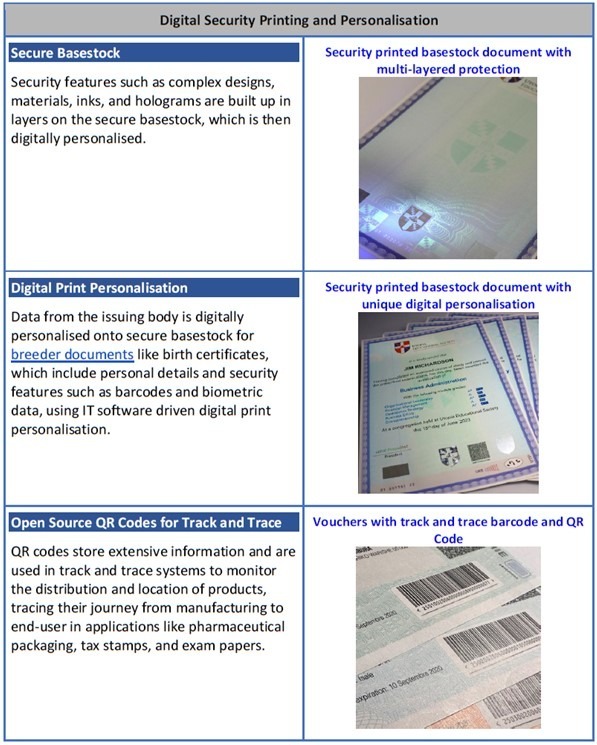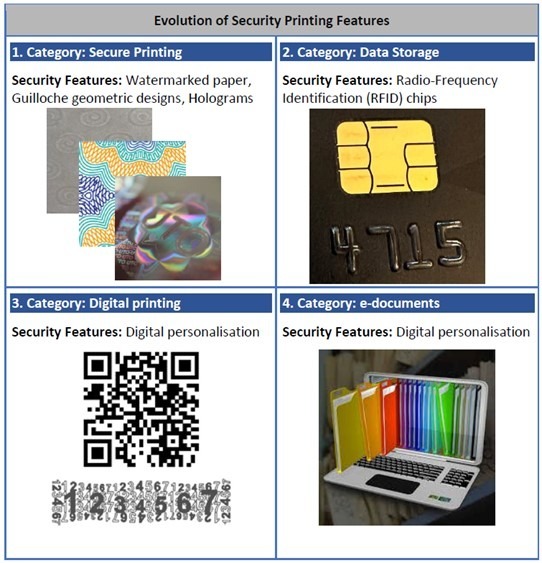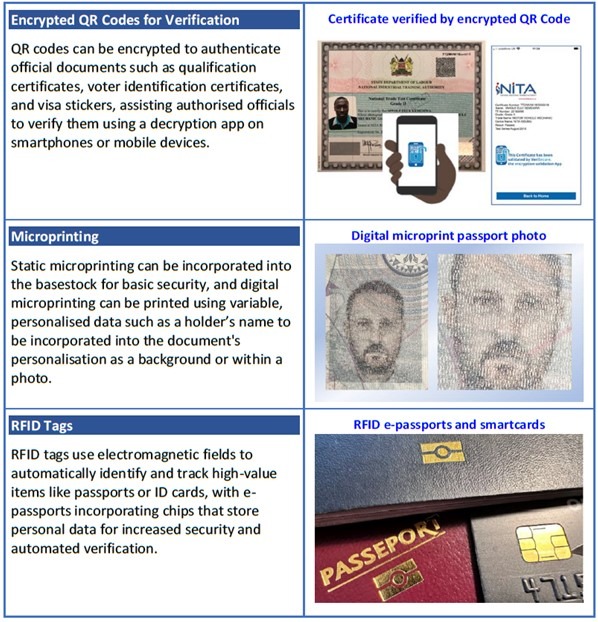
BLOG
5 June 2024
Securing the Future: E-documents and Innovations in Digital Verification
Imagine preparing for an international conference, with your e-visa stored securely on your smartphone. As you walk through airport security, digital verification processes quickly authenticate your visa without the need for paper documents.

Imagine preparing for an international conference, with your e-visa stored securely on your smartphone. As you walk through airport security, digital verification processes quickly authenticate your visa without the need for paper documents. This is the innovative world of security printing and digital verification, where travel becomes faster and more secure with the power of e-documents.
Security Printing Journey: Physical Techniques to Digital Solutions
The future of securing documents and identities has evolved in two main directions, which will structure our article: first, security printing has evolved from solely physical methods to a combination of physical and digital techniques; and second, verification has shifted from relying on visual inspections and scanners to utilising e-documents encrypted with digital access. While secure printing, whether offset, screen, intaglio, digital, or hybrid, remains a popular choice among many industry stakeholders, the future lies in innovations in the digital verification of e-documents.
We see various reforms in digital authorisation and verification with positive implications, such as the issuance of e-visas to boost tourism economies recovering from COVID-19 travel restrictions, alongside the UK’s plan to replace visa stickers with e-visas within the next 2 years. However, there are also less practical outcomes, such as a recent outage that delayed passport e-gate processing at UK airports due to a network issue in early May 2024 or digital ticketing causing entry issues for Liverpool fans at a Wembley game in early 2024.
This blog explores the evolution of security printing technology, discussing the transformative benefits and emerging challenges to provide an overview of the future of secure identity and e-documents.
The Historical Evolution: From Secrecy to Security Printing
Historically, the first attempt to protect a document or valuable item was to hide it in a safe place, and still make it accessible for the owner only. Over the centuries, as technology advanced, so did methods of securing valuable items. For instance, we use currency for transactions, but in the past, goods were often exchanged based on the value of gold. So, the concept of gold as a guarantee still underpins monetary currency. Likewise, whether dealing with educational qualifications or any form of identity credentials, whether paper-based or digital, there is a fundamental need for verification.
The below outlines the advancements in key features of security printing technology, accompanied by visual illustrations:
Evolution of Security Printing Features
Examining the table of advancements in key features of security printing from a market perspective, we now observe the emergence of a new product cycle – e-documents are taking precedence.
A more detailed exploration of security printing and its critical role can be found in our previous blog post titled Beyond the Visible: Exploring the Hidden World of Security Printing. So, having explored the evolutionary advancements in security printing, let’s now turn our attention to modern digital security printing technologies.
Advancing Protection: Digital Security Printing and Personalisation
Digital security printing technologies have transformed protection and authentication by enabling extensive data personalisation in documents that previously held only basic information like the holder’s name and photo. In this section, we explore the foundational security of secure basestock, insights into digital print personalisation, dynamic track and trace capabilities, and advanced security of encrypted QR codes and RFID tags, with practical examples from the security printing industry.
Digital Security Printing and Personalisation
As we can see, the integration of secure basestock, digital personalisation, QR codes, and RFID tags has fundamentally transformed document protection and authentication, improving security and simplifying verification processes to systematically protect high-stake documents against modern threats, setting the stage for further exploration of how these technologies are transforming industry practices.
Transforming Industries: The Rise of E-Documents and Digital Verification Technologies
The growth of e-document technologies reflects the progressive shift from physically printed documents to exclusively electronic formats, which are fully digital and typically created online. Following is a list of prevailing e-document technologies that impact various industries:
E-Visas. In the travel sector e-visas are being implemented to replace visa stickers in countries that require entry permits.
E-certificates. In recognition of merits, awarding bodies started to offer e-certificates as an alternative to traditional physical certificates in educational and professional sectors.
E-tickets. In large-scale event management tickets are now distributed online for venue access, providing fast verification, though some fans prefer physical tickets for their trustworthiness and as souvenirs.
E-tax receipts. In the provision of evidence for tax status and payments some national authorities, such as the UK for its vehicle tax system, issue e-tax receipts, while others continue to issue physical receipts.
Online Communication. In customer engagements, we have shifted from traditional letters, brochures, and manuals to targeted SMS messages, emails, downloadable PDFs, and online content.
Online Testing and E-Marking: In the assessment industry online testing and e-marking have become preferred solutions, replacing paper-based question papers and manual marking for national examinations and professional qualifications.
Note: It’s also important not to confuse e-documents with e-passports; an e-passport is a physical passport that includes an RFID chip.
As the widespread adoption of e-document technologies improves processes and increases accessibility across various sectors, we now transition to exploring the important role of cyber measures and compliance in protecting these e-document transactions and more in the next section.
Document Protection: Cyber Measures and Compliance
One thing that is clear in both physical security printing and online e-documents is the critical role that data handling and software play in presenting and distributing information to users. IT is the growth area across all sectors, developing processes and providing cyber security which is recognised by the Government through specialist agencies such as the UK National Cyber Security Centre (NCSC) which is a part of GCHQ. Organisations must be able to demonstrate that data is protected which can be provided through certification and regulation including:
– ISO27001 Information Security Management System
– Cyber Essentials Plus certification
– Information Commissioner registration
– GDPR compliance
So, the level of cyber protection is relevant for both physical and e-documents, as in both cases the handling and protection of sensitive personal data is the objective with the balancing act explained in detail in our next section.
Balancing Act: The Pros and Cons of E-Documents and Digital Verification
Challenges of e-document and digital verification
While e-document solutions and digital verification systems offer numerous benefits, they encounter significant challenges, detailed below, that can hinder their adoption and effectiveness:
High Costs and Infrastructure Needs. The deployment of e-documents and digital verification technologies involves high costs for development and maintenance. Reliable power and internet access are prerequisite, especially during high-stakes, time-sensitive events, where their absence can cause disruption, such as the technology failure at a time-sensitive football event at Wembley Stadium.
Security Risks and Fraud. Both e-documents and their digital verification processes are susceptible to online threats, increasing the potential for fraud and scams. Incidents like the $25 million deepfake scam that victimised Arup and the fake Taylor Swift concert tickets scam reported by Lloyds Banking Group illustrate the severe risks these technologies pose to economic stability and trust in online systems.
Accessibility and Equity. Ensuring equitable access to digital verification technologies is a major challenge. Disparities in technology access can impact the fairness of services like education and voting. The UK’s implementation of Voter Photo ID laws, which includes the provision of a free Voter Authority Certificate for voters without photo ID, highlights the challenges in ensuring democratic access for all citizens. Although the UK’s Digital Strategy Policy emphasises a commitment to supporting digital transformation to build a more inclusive, competitive, and innovative digital economy – a movement accelerated by the COVID-19 pandemic – it remains clear that physical documents still play an essential role in certain areas.
A more balanced approach ensures that both e-documents and digital verification are addressed equally and if necessary offered as a combination of physical and digital techniques to highlight specific needs and challenges, and their impacts across various sectors. Despite these challenges, the advantages of e-documents and digital verification present transformative opportunities, which we will explore in the following section.
Benefits of e-document and digital verification
E-document solutions and digital verification offer numerous advantages that improve operational efficiencies across various sectors. For e-documents, these benefits include lower operational costs, reduced environmental impact, and the ability to instantly distribute and track documents. This not only boosts efficiency but also cuts down on resources used in traditional paper-based processes, while the immediacy of digital distribution speeds up decision-making and improves service delivery across both public and private sectors.
On the other hand, physical verification technologies including UV and IR verification, and digital verification technologies, including barcodes, QR codes, RFID chips, and biometric systems, improve security and authentication by supporting higher accuracy, reducing fraud, and protecting sensitive information, while quickly and reliably validating documents and identities in areas with strict security requirements.
The table below illustrates how both e-documents and digital verification technologies are becoming central to modern authentication and payment processes, offering substantial benefits to stakeholders at large:
Outline of Verification Technologies
| Verification mode | Verification Technologies | |
| Printed documents | E-documents | |
| Visual Inspection | Document Examiner | Document Examiner |
| UV Verification | Various Ultra Violet wavelength lights | |
| IR Verification | InfraRed Detection Equipment | |
| Barcode / QR Code | Barcode Scanner and Software Solution | Barcode Scanner and Software Solution |
| RFID Chip and Biometrics | RFID Reader, Terminals and Software Solution | |
| Digital Verification | Smartphone App and Software Solution | Smartphone App and Software Solution |
| Forensic Verification | Laboratory | |
This table highlights the integral role of e-documents and digital verification technologies in modernising security and authentication, simplifying operations and advancing us toward a more efficient and transparent digital landscape.
Final Thoughts: The Impact of Security Printing and Digital Verification
We see that the integration of physical and digital security measures is not just a trend but a necessity. The transformation from traditional to digital techniques reflects a significant shift in how we protect and authenticate documents, driven by the demands for higher security and drive for efficiency. Innovations such as e-documents, encrypted QR codes, and RFID technologies have introduced new paradigms in how information is secured and verified, offering significant benefits such as reduced costs, environmental sustainability, and immediate accessibility.
However, these advancements also bring challenges, including technological dependencies that can create vulnerabilities and unequal access across different demographics. Addressing these challenges is a must for making sure that the security measures we rely on continue to be useful and inclusive.
Whilst advancements in e-documents and verification are clearly present now and in the future, there also remains a need to provide elements of our society with physical documents, with an overall hybrid approach to best serve the market.
So, the next time you walk through airport security with your e-visa nicely stored in your smartphone, take a moment to appreciate the innovative world of security printing, e-documents and digital verification.
About the Author
Vali Huseyn is an accomplished educational assessment specialist, with extensive experience in all aspects of the assessment lifecycle, including the integration of secure printing solutions to ensure the integrity of assessments. Vali’s work involves collaborations with technology providers, certification bodies, and research institutions, contributing significantly to the assessment sector. At The State Examination Centre of Azerbaijan, Vali was instrumental in modernising large-scale assessments and spearheaded several projects aimed at improving learning and assessment across the Post-Soviet region.
Feel free to connect with Vali on LinkedIn to discover best practices for transitioning to secure, technologically advanced security printing solutions.





